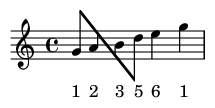Summary:
This article is a comprehensive guide to the major pentatonic scale, a fundamental five-note scale that forms the melodic backbone of music across countless genres and cultures. Discover its simple formula, understand the theory behind its universally pleasing sound, and learn to apply it with practical examples, including famous melodies and improvisation exercises. A cornerstone of music education, this scale is a powerful and essential tool for any musician.
Keywords:
major pentatonic scale, music theory, improvisation, five-note scale, music education, scales, guitar scales, piano scales, melody writing, music theory for beginners, songwriting, consonant intervals
Introduction: What is That Familiar Sound?
Have you ever listened to a folk song, a rock guitar solo, or a simple lullaby and felt an immediate sense of comfort and warmth? The secret behind this universal appeal often lies in a simple, yet powerful, melodic tool: the major pentatonic scale. This five-note scale is arguably the most widespread scale in the world, found in ancient chants and modern pop hits alike. Its beauty is in its elegant simplicity. By removing the notes that create the most tension, the major pentatonic scale provides a "can't-go-wrong" palette for creating pleasing and memorable melodies. Let's dive into this essential building block of music.
Definition and Structure
The word "pentatonic" literally means "five tones" (from the Greek words *pente* meaning five, and *tonos* meaning tone). The major pentatonic scale is a specific type of five-note scale known for its bright, happy, and open sound. You can think of it as a streamlined version of the standard seven-note major scale.
The Formula
To build a major pentatonic scale, you simply start with a major scale and remove the 4th and 7th scale degrees.
- The Major Scale formula is: 1, 2, 3, 4, 5, 6, 7
- The Major Pentatonic Scale formula is: 1, 2, 3, 5, 6
For example, let's take the C Major scale: C, D, E, F, G, A, B.
If we remove the 4th note (F) and the 7th note (B), we are left with the C Major Pentatonic scale: C, D, E, G, A.
Why Does It Sound So Good? The Science of Simplicity
The "magic" of the major pentatonic scale comes from the notes it omits. The two notes removed from the major scale, the 4th and 7th degrees, are the very notes that create the most dissonance. In the key of C Major, these are F and B.
These two notes form a tense-sounding interval called a tritone. They also create the only semitone (or half-step) intervals within the major scale (E to F, and B to C). By removing these tension points, the major pentatonic scale is left with only strong, consonant intervals. This lack of dissonance is what gives it a stable, open, and universally pleasing quality.
The Relative Minor Connection
Every major pentatonic scale has a "relative" minor pentatonic scale, which uses the exact same set of notes but starts on a different root, giving it a more melancholic sound. The root of the relative minor is always the 6th degree of the major scale.
For C Major Pentatonic (C, D, E, G, A), the 6th note is A. This means the notes of C Major Pentatonic are identical to the notes of A Minor Pentatonic (A, C, D, E, G). This powerful relationship is a key shortcut for improvising over both major and minor chord progressions.
Examples in Notation
Basic Scales
Here is the C Major Pentatonic scale. The numbers below indicate the scale degrees (1, 2, 3, 5, 6). Notice the open, consonant sound as you play or listen to these notes.

The principle is the same for every key. Here is the G Major Pentatonic scale (G, A, B, D, E) , which requires an F-sharp in the key signature.

Famous Melodic Example: "Amazing Grace"
Countless folk and popular melodies use the major pentatonic scale. The opening line of "Amazing Grace" is a perfect example, written here in G Major and using only notes from the G Major Pentatonic scale (G, A, B, D, E) .

Harmonic Context: Scale Over a Chord
To see why the scale works so well for improvisation, let's look at the C Major Pentatonic scale played over a C Major chord (C-E-G) . The scale notes either match the chord tones perfectly (C, E, G) or add pleasing, stable colors (D, A). There are no harsh clashes.
Practical Applications
The major pentatonic scale isn't just a theoretical concept; it's one of the most practical tools in a musician's kit.
- Improvisation: For guitarists, pianists, and other instrumentalists, this scale is the gateway to improvisation. Its lack of dissonant intervals means that any note from the scale will sound good over a corresponding major chord or progression. For more advanced phrasing, try emphasizing the chord tones (1, 3, 5) on strong beats and using the other notes (2, 6) as passing or connecting tones.
- Melody Writing: Many of the world's most famous melodies are built from the major pentatonic scale. The opening guitar riff of "My Girl" by The Temptations and the melody of "Amazing Grace" are classic examples. Its simple, strong structure makes it perfect for creating catchy, singable tunes that stick in your head.
- Music Education: Because it's so forgiving, the major pentatonic scale is heavily used in music education, particularly with the Orff Schulwerk approach. Instruments like xylophones and glockenspiels are often set up in a pentatonic scale (by removing certain bars) so children can freely experiment with creating music without hitting a "wrong" note.
Historical Figures and Influence
While the pentatonic scale is too ancient to be credited to a single inventor, many musicians and composers are celebrated for their masterful use of it. Composer Claude Debussy, an innovator of the Impressionist movement, was fascinated by the sounds of the Javanese gamelan, which relies heavily on pentatonic and other non-Western scales. He incorporated their open, floating quality—a direct result of avoiding the strong pull of the 7th degree leading tone—into his works like "Pagodes" to break from the traditions of Western harmony.
In the 20th century, rock guitarist Duane Allman of The Allman Brothers Band built a legendary sound around the major pentatonic scale. His genius was not in using complex scales, but in his soulful phrasing, rhythmic precision, and ability to make this simple five-note scale sing. His solo on "Blue Sky" is a masterclass in melodic, major pentatonic improvisation that has inspired generations of guitarists.
Fun Facts and Getting Started
The major pentatonic scale is full of surprises!
Instant Improv on the Piano: Did you know that if you play only the black keys on a piano, you are playing a G-flat major pentatonic scale (Gb, Ab, Bb, Db, Eb)? This is a fantastic way for beginners to start improvising with a guaranteed pleasant sound. Sit down at a piano and experiment—you can't play a wrong note!
Ancient Origins: The scale's origins are incredibly ancient. Bone flutes dating back over 40,000 years have been discovered with holes drilled to produce pentatonic scales, suggesting it might be one of humanity's very first musical structures. Its prevalence in so many different, unconnected ancient cultures (from Africa to Asia to the Americas) suggests it may be a naturally occurring musical preference for the human brain.
Conclusion: Your Turn to Create
The major pentatonic scale is far more than just a collection of five notes. It is a key that unlocks melody, a gateway to improvisation, and a thread that connects music from across time and around the globe. Its simple, consonant structure makes it approachable for beginners, while its expressive potential allows it to be a lifelong vehicle for musical masters. By understanding how it's built and hearing it in context, you've taken a significant step in your musical journey. The next time you listen to your favorite song, try to hear its bright, open sound. Better yet, pick up your instrument, use the examples in this article as a starting point, and see what timeless melodies you can create.
References:
Levine, M. (2009). The Jazz Theory Book. Sher Music Co.
Sloboda, J. A. (2001). The Musical Mind: The Cognitive Psychology of Music. Oxford University Press.
Hewitt, M. (2013). Musical Scales of the World. The Note Tree.
